Cover crops are crops planted between periods of normal crop production, or between the rows of some crops, with the primary purpose of conservation or soil improvement. Most cover crops are not harvested, but some are harvested as forage or grazed by livestock. A significant amount of labor and machine hours are used to manage cover crops. This guide will focus on equipment used to plant cover crops.
As interest in cover cropping and climate-smart agriculture expands and evolves, the labor and machinery needed to plant and terminate cover crops increases. Approximately 15.4 million acres of cover crops were planted in 2017, the last data available from the USDA Census of Agriculture. Cover crop acreage is estimated to have increased substantially since 2017. Many equipment manufacturers are creating or modifying equipment lines to meet producer demand for cover crop equipment.
The largest expense of cover cropping, behind the cost of seed, is the machinery and labor cost of planting and terminating the cover crop. Cover crop selection affects machinery needs; equipment availability affects cover crop species selection. Farmers adding or expanding cover crops face multiple machinery management decisions. Cost, coverage rate, labor and power availability, and the goals of your cover cropping system all affect machinery decisions.
Equipment cost is critical in cover crop machinery decisions. As with most machinery decisions, farmers want equipment that works well at minimal cost. Some producers may choose to integrate cover crop field activities with existing field operations. Using equipment that is already leased or owned reduces the cost of cover crop planting equipment.
Coverage rate, or number of acres sown per hour, is critical when choosing cover crop equipment. Faster seeding relieves fieldwork demands and provides more days for cover crop growth. Faster seeding maximizes labor and equipment available for other field operations.
Cover crop seeding takes place during either late summer or fall on most corn and soybean farms. Fall cover crop seeding coincides with harvest and other fall fieldwork, making labor and power availability key considerations. Some producers may elect to seed cover crops earlier in the growing season to avoid conflicting with harvest and fall fieldwork. Others may modify equipment to incorporate seeding with fall tillage, harvesting, or fertilizer applications.
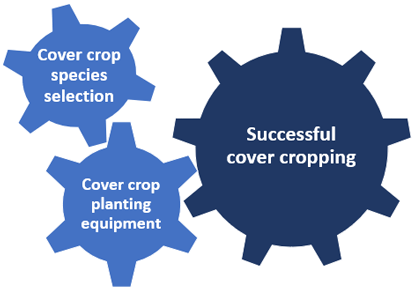
The agronomic attributes of various cover crop species also influence the tools chosen to plant them. Cereal rye, the most popular cover crop in the Corn Belt, can easily be seeded with equipment that is already used to sow wheat. Smaller-seeded cover crop species may do better when broadcast seeded alone or spread with a fertilizer application. Figure 1 illustrates the connection between species selection and equipment choice.
Timing of planting is critical to establish and grow cover crops before winter. Some cover crops may require more growing days than are available after harvest. Other types of cover crops will not survive winter; they must be planted early enough to get effective growth before a killing freeze. Species that need to be seeded prior to harvest, to establish and grow before winter, will require equipment designed to minimize damage to growing row crops.
Table 1 summarizes common equipment options for planting cover crops. Since there are so many variables to cover crop seeding, there is no one-size-fits-all method.
Table 1. A summary of cover crop seeding machinery and their key attributes.
| Seeding method1 | Equipment cost (2023)2 | Coverage rate (acres/hour) | Seeding quality3 | Operational integration | Seed size and consistency |
|---|---|---|---|---|---|
| Machinery appropriate for seeding after harvest of cash crops | |||||
| Box drill (20) | $49,000 | 15 | Excellent | None | Medium to large |
| Air drill (40) | 230,000 | 30 | Excellent | Fall fertilizer | All sizes, mixes |
| Row crop planter (30) | 150,000 | 25 | Excellent | None | Large |
| Pendulum spreader (30) | 5,000 | 35 | Fair | None | Small to medium, mixes |
| Dual spinner spreader (60) | 27,500 | 75 | Marginal | Fall fertilizer | Small to medium, mixes |
| Air boom spreader (80) | 82,500 | 100 | Fair | Fall fertilizer | Small to medium, mixes |
| VT seeder attachment (30) | 17,500 | 30 | Good | Fall tillage | All sizes, mixes |
| Combine mounted seeder (30) | 32,500 | 15 | Good | Harvest | Small to medium, mixes |
| Machinery appropriate for seeding into standing cash crops | |||||
| Sprayer mounted air boom (90) | 85,000 | 100 | Fair | In-season fertilizer | Small to medium, mixes |
| High clearance spreader (80) | 42,500 | 80 | Marginal | In-season fertilizer | Small to medium, mixes |
| Row based interseeder (30) | 35,000 | 25 | Good | None | All sizes, mixes |
| Aerial application—drone (20) | 40,000 | 50 | Marginal | None | Small to medium, mixes |
| 1. Equipment width, in feet, is included in parentheses 2. Power cost is not included unless seeder is integrated into the equipment, cost are approximated based on manufacturer estimates. 3. Seeding quality is a measure of how well a machine sows seed based on seed-soil contact and how evenly and precisely seed is applied. |
|||||
Post-harvest seeding option
Seeding cover crops after harvest occurs when operator labor and machinery demand is high. Post-harvest seeding is flexible with many seeding methods and increases the opportunity to use implements that the farm may already own or lease for cash cropping activities.
Implement choice also depends on the cover crop species being planted. Many fall-seeded cover crops have larger seeds, such as cereals or winter peas. Drills or row crop planters are good options for seeding these species.
Smaller seeded species, like clovers and brassicas, may be better suited to broadcast seeding. They require less seed-soil contact, and their extremely small size may make metering seeds difficult. Dry fertilizer and smaller cover crop seeds can be mixed and broadcast together after harvest of the cash crop. This can save a trip over the field and reduce the number of operators and machines needed for fall fieldwork. Similarly, fall tillage implements can be equipped with attachments that seed cover crops during tillage.
Row crop planters
Most row crop operations have a row crop planter. A row crop planter can work as a cover crop seeder, with minimal modifications. Planters are expensive tools to operate as they can have tight tolerances for wear and many complex moving parts. Seeding cover crops may cause undesired wear to the planter. Planters also typically have wider row spacing than is ideal for cereals or legume cover crops, leading to gaps in soil coverage. Benefits of using row crop planters include good seed-soil contact, excellent emergence, and the ability to cover ground rapidly. Row crop planters may work poorly when used for seed mixes or extremely small-seeded cover crops. Figure 2 shows a row crop planter planting cover crops in a harvested soybean field.
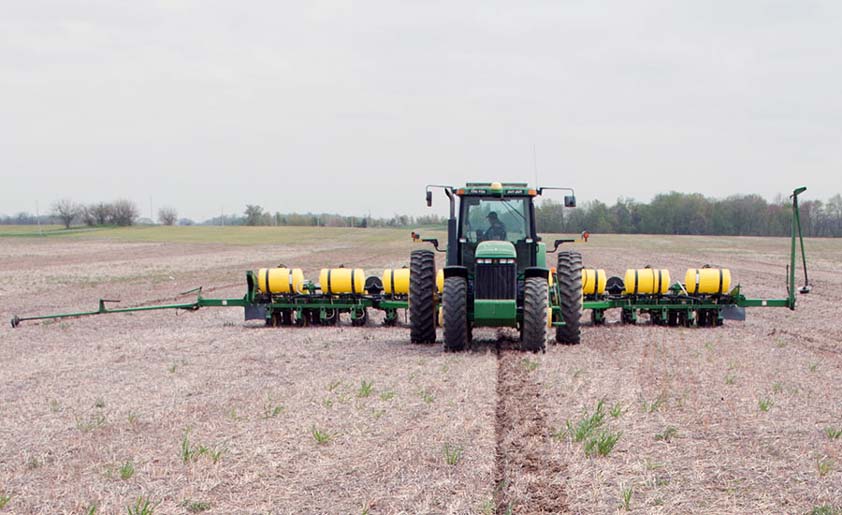
Equipping split-row planters with high-precision guidance (RTK) provides the ability for producers to plant both winter-killed and cold-tolerant cover crops simultaneously while following a set tramline through the field with sub-inch accuracy. By doing so, the nutrients scavenged by the winter-killed crop can be more immediately available to the succeeding cash crop by planting into a clean seedbed where the winter-killed row was located. Meanwhile, the cold-tolerant species is allowed to accumulate additional biomass and control weed pressure prior to termination.
Box drills
Drills can be used to plant a cover crop directly after harvest. They provide good seed-soil contact. However, speed and width are limited, and operating costs per acre can be higher than other implement options. Drills are a good compromise between seeding precision and flexibility, as they can lay down a measured number of seeds in a specific area and may be used for a greater range of seed sizes and weights than row crop planters.
Box drills are simpler and less expensive than either planters or air drills. Some end-wheel style box drills do not provide any downforce beyond the weight of the row units — insufficient for many no-till conditions. No-till box drills, as shown in Figure 3, use the weight of the box, frame, and seed payload to hold the row units in the ground, enabling good seeding in tight soil or high residue scenarios. No-till box drills are, in many situations, well suited for cover cropping goals.
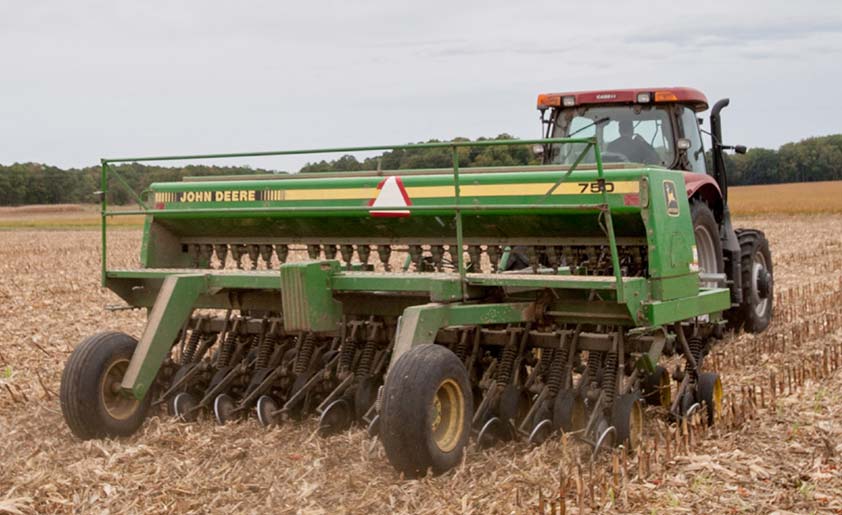
Air drills
While similar to box drills, air drills as seen in Figure 4 offer faster seeding as they are frequently more than 40 feet wide. However, they can be much more expensive and are uncommon in certain regions of the country. Air drills are more complex than no-till box drills and could require a skilled operator. Their large size may also require a larger tractor. Air drills may be equipped to apply fertilizer along with cover crop seed.

Pendulum spreader
Pendulum spreaders are the least expensive commonly used cover crop seeder. Typically holding 30 to 50 cubic feet of material, pendulum spreaders work well for the relatively light application rates of many cover crops. The oscillating spreader arm provides good side-to side distribution of seed, and most units spread about 40 feet wide with dense material. With light seeds, working width may suffer. Compared to other broadcast seeders, the working rate with pendulum spreaders is poor because of their narrower working width and small capacity leading to more frequent refills. Pendulum spreaders may lack the capacity for commercial applications of fertilizer, leaving no convenient options for combining operations in the fall.
Spinner spreader
Spinner spreaders are widely available and are owned by some mid- and large-sized farms. Spinner spreaders are relatively inexpensive and distribute product in large swaths at high speeds, making them very affordable to operate. Another benefit is that seed can be combined with fertilizer applied with the spinner spreader. Spreading seed evenly is challenging with a spinner spreader, and seed-soil contact is poor. Increased seeding rates may be needed to compensate for lower germination rates due to poor seed-soil contact.
Air boom spreader
Air delivery broadcasters address many of the disadvantages of spinner spreaders. The front of both machines is nearly identical, but the air boom spreader replaces the spinner apparatus with a blower and boom system that spreads seed evenly across the entire width of the machine. Additionally, seed mixes and small-seeded crops can be handled with ease using an air boom. Wind has less impact on the spread pattern of an air boom spreader. Air boom spreaders retain the rapid coverage rate of spinner spreaders and the ability to merge seeding with fertilizer application but are more costly to own and maintain. A small air boom spreader suitable for seeding cover crops on many farms is shown in Figure 5.

Vertical tillage tool seeder attachment
Seeding attachments on vertical tillage (VT) implements can integrate cover crop seeding with fall conservation tillage practices. This minimizes seeding labor and equipment costs by combining seeding with an existing tillage pass. The VT seeder attachment is a relatively low-cost tool. Seeder attachments use the harrow portion of the VT tool to incorporate seed lightly into the soil, improving seed-soil contact and boosting emergence. A VT implement with mounted air seeder is seen in Figure 6.
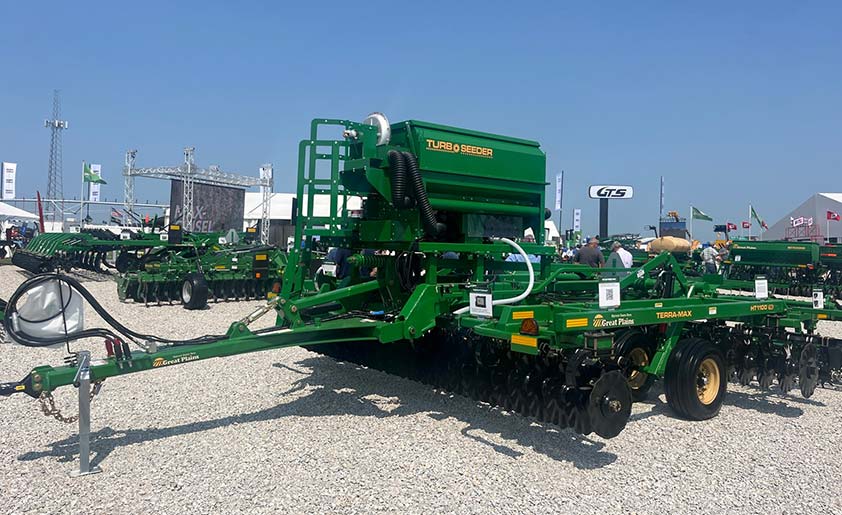
Combine-mounted seeder
Some companies offer combine attachments that seed cover crops as the combine moves through the field. Like a VT cover crop attachment, combine attachments usually include a seed box, blower and tubing system that runs seed to the header or straw spreaders. The advantages and disadvantages of spinner spreaders or air boom spreaders apply to combine-mounted cover crop seeders. An added mulching effect can be delivered by the chaff, increasing germination over other broadcast seedings. An example of a combine-mounted seeder is shown in Figure 7.
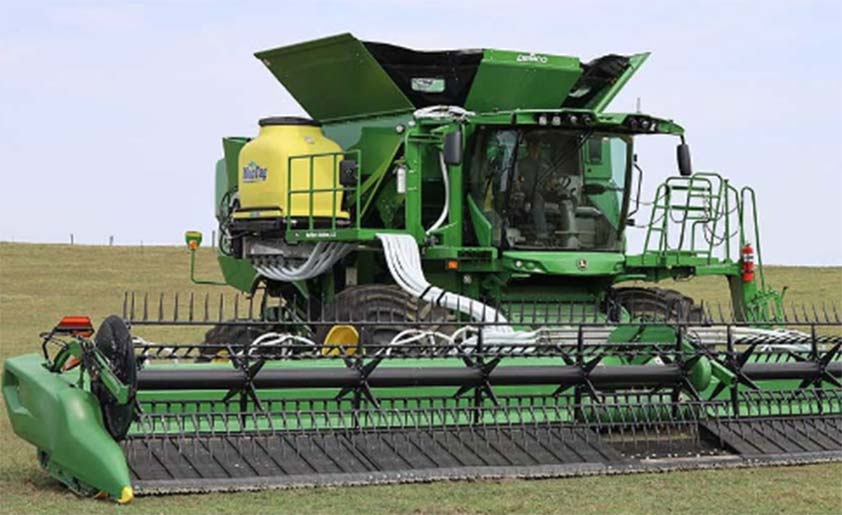
Seeding into standing crops
Planting covers crops earlier than cash crop harvest offers several advantages. Many growers elect earlier planting to seed a wider range of cover crop species, which can provide additional benefits to their farm. Some farmers prefer earlier seeding to produce additional biomass before the cover crop dies or goes dormant. Others use early-planted cover crops in their weed control program. The term “interseeding”, defined as seeding into another growing crop, describes this type of planting.
Interseeding requires machinery that minimizes crop damage while facilitating good cover crop establishment in light-limited situations. High clearance machines and aerial equipment are used for in-season cover crop seeding. Standard height machines may be used for cover crop seeding earlier in the row crop growing season.
Interseeding of cover crops can take place at two time periods of the growing season. Early interseeding of cover crops into corn, at about the V5 growth stage, is being done in primarily the northern part of the Corn Belt. Challenges of this practice include proper herbicide selection and management to minimize damage to the cover crop and selection of cover crop species with high shade and drought tolerances. This practice seems to be showing the most promise from Interstate 80 north. Late interseeding into corn would be when corn leaves have dried up to the ear allowing about 50 percent light penetration. For soybeans late interseeding would be when leaves are beginning to yellow, but before leaf drop. Leaf drop after seeding provides a mulching effect on the seed. Ground-based seeding at this time will result in some yield loss from tire traffic.
Sprayer-mounted air boom
Some experienced cover croppers have built attachments for their row crop sprayers or designate an older sprayer as a cover crop seeder. These units use the sprayer’s power unit, high clearance frame, and boom structure but replace the liquid application hardware with a seed box, blower, and tubing to apply seed between the rows of standing crops. Retrofitting these machines can be costly but they cover ground rapidly and offer a wide seeding window for a variety of cover crop species. A sprayer equipped to seed cover crops can be seen in Figure 8.

Like the seed delivery system on a VT attachment or air boom spreader, high-capacity blowers and metering systems are required for the sprayer boom’s width and fast ground speed. The labor required to swap the sprayer to the seeding equipment and back can be an obstacle to this type of seeding. Kits can be purchased to convert specific models of sprayers to seed cover crops but can be more expensive than estimated costs of custom-built units.
High clearance spreader
High clearance spinner spreaders can combine cover crop seeding with mid- or late-season dry fertilizer application. Self-propelled models have similar clearance as row crop sprayers — about 4 feet. Many tractor-drawn spreaders offer more than three feet of clearance. Their use is limited by the tractor’s clearance. Using a high clearance spreader allows a grower to seed into soybeans nearly anytime and seed into corn before its aggressive, mid-season growth period. Cover crop seeding can be combined with a granular nitrogen application to corn. Seed distribution patterns and machinery clearance issues during later season applications may be challenges for high clearance spreaders. High clearance spinner spreaders and air boom type spreaders are both available. Figure 9 shows a spinner-style high clearance spreader.

Row-based interseeder
Farmers who are comfortable with cover cropping and are looking for a precise tool for in-season establishment have begun to use interseeders to plant cover crops between rows of growing corn and soybeans. Crop size must be relatively small (two feet tall or less and not canopied) for interseeding to work. An interseeder offers excellent seed-soil contact. However, field coverage rate is slower as speed is limited to around 6 mph to minimize crop damage. Unit width is typically restricted to 40 feet, but some custom-built units may be up to 60 feet wide.
Interseeders, as seen in Figure 10, are almost always fully mounted to the tractor for following rows, and the weight of the unit must be kept down to maintain tractor stability. Organic operations can combine this type of seeding with a mechanical weed control pass, capturing additional efficiency.

Aerial application
Airplanes, drones, and helicopters all have potential for seeding cover crops. Aerial application is most adapted to small-seeded, low-rate cover crops that are time sensitive. This would include species such as turnips, clovers and annual ryegrass. Species, such as cereal rye, with a higher seeding rate and planting window would not be a candidate for aerial seeding. The primary advantage of aerial seeding is that crop damage is eliminated. Figure 11 shows an agricultural drone equipped for seeding.
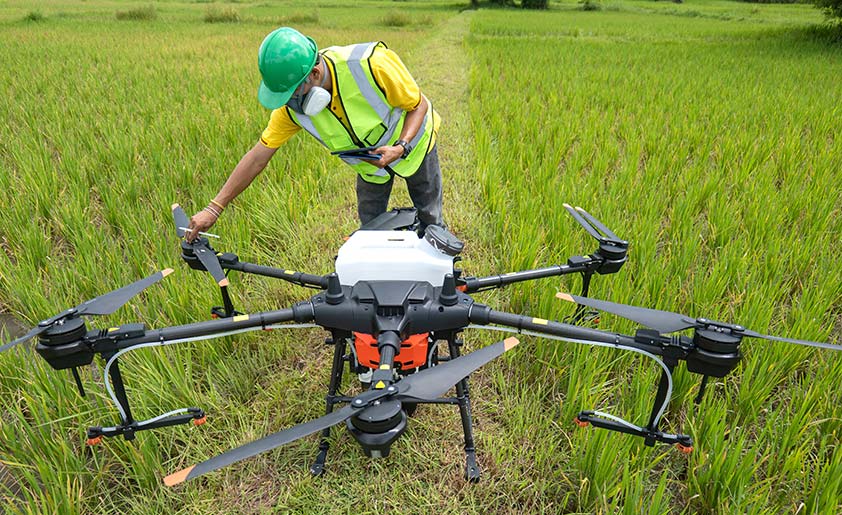
For large, open fields, airplanes operated by custom applicators can be a fast, efficient way to seed many acres. Smaller, tree-lined fields are less suitable for airplane seeding. Both drones and helicopters are better suited for smaller fields but may work at a slower rate and cost more per acre. Some farms may be able to purchase their own drones, allowing an extra degree of freedom in application timing and strategy. The uniformity of seed spread and seed-soil contact is similar to that of a high clearance spinner spreader.
Summary
Planting considerations are a major decision for farmers using cover crops. The choice of cover crop species and planting date affects the choice of planting equipment. Similarly, the choice of seeding equipment may also affect the seeding rate for good establishment and what species of cover crop may be planted. Using existing equipment may limit the options available for cover crop management but keep cover crop costs reasonable.
Cover cropping is a farming system decision affecting both cash crop decisions and cover crop options. The choice of cover crop planting equipment is optimized when considered within the system of preferred planting date, appropriate planting rate and integration with other fieldwork.